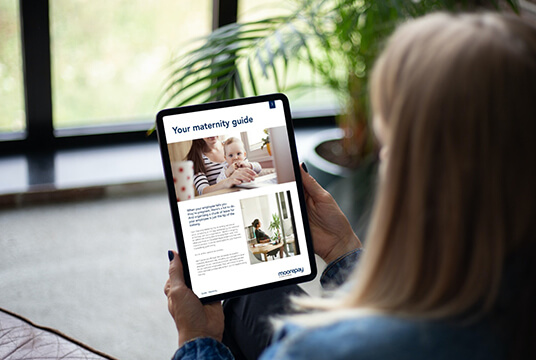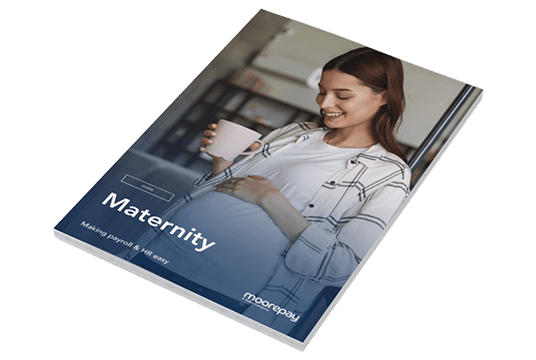Ultimate guide
Your ultimate guide to maternity
When your employee tells you they’re pregnant, there’s a lot to do. And organising a chunk of leave for your employee is just the tip of the iceberg.
From Statutory Maternity Pay, to sorting out annual leave, to scheduling in KIT days, there’s a lot to organise. And when you throw in the added legal protections that expectant and new mothers receive, it can be catastrophic for your business if something goes wrong.
But all of this needn’t be stressful. That’s why we’ve created the only guide to maternity you’ll ever need (we hope)!
Plus, we’ll throw in some FAQs and best practise advice from our HR experts along the way. So buckle up and let’s get started.

Contents
Go straight to the topic you’re interested in by clicking on the text below.
-
Chapter 1
Maternity leave: the basics
-
Chapter 2
Maternity leave entitlement
-
Chapter 3
Holidays and benefits
-
Chapter 4
Keeping in touch
-
Chapter 5
Maternity and redundancy
-
Chapter 6
Statutory Maternity Pay
-
Chapter 7
Other types of maternity pay
-
Chapter 8
Pay rises and bonuses
-
Chapter 7
Protecting expectant mothers at work
-
Chapter 10
Take away this guide

Chapter 1
Maternity leave: the basics
In this chapter you’ll learn
- An overview of Statutory Maternity Leave
- Who's eligible?
- Can trans men still get “maternity” leave?
So, first thing’s first. Who can receive Statutory Maternity Leave (SML)?
To qualify, the person must first be an employee of your company. And it doesn’t matter how long they’ve been working for you – they are entitled to take 52 weeks of maternity leave from day one of their employment. Yep, there’s no length of service required.
The other rule is the employee has to tell their employer at least 15 weeks before the baby is expected. They should let their employer know when it’s due and when they want to start taking their leave. This doesn’t have to be in writing, unless the employer requires it, but we would recommend this to avoid any confusion.
Can trans men still get “maternity leave”?
Some transgender men will be able to bear a child. In this circumstance, the law is a bit of a grey area.
Similar to surrogacy, the act of giving birth to the child is what gives the entitlement to the maternity leave and at times pay.
So from this, we can assume trans men would still get maternity leave and pay, if eligible.

Learn more about maternity leave regulations
There’s a lot of legislation surrounding Statutory Maternity Leave.
Find out all of the rules and regulations in this in-depth webinar with our experts.

Chapter 2
Maternity leave entitlement
In this chapter you’ll learn
- What are my obligations during pregnancy?
- When can an employee take their leave?
- What are an employee’s rights when they return from maternity leave?
- What happens if there’s a tragedy?
What is a pregnant employee entitled to?
An employee is entitled to up to 52 weeks of Statutory Maternity Leave.
That’s 26 weeks of Ordinary Maternity Leave (OML) and 26 weeks of Additional Maternity Leave (AML). Note that this distinction doesn’t relate to pay. Its significance is that the employee has different rights depending on what stage of Maternity Leave they’re at.
During their pregnancy, they’ll also be entitled to ‘reasonable’ paid time off during working hours to recover from pregnancy-related illness or to attend antenatal appointments, which includes any travel time.
What are my employer obligations during pregnancy?
An employer is required to confirm the start and end date of the Maternity Leave, and any Statutory or Contractual Pay. This is required in writing, by law, within 28 days.
When can an employee take their leave?
The earliest the employee can start their leave is 11 weeks before the expected week of childbirth (EWC). And the latest they can start leave is the day after the baby is born.
If an employee is absent from work wholly or partly due to pregnancy during the 4 weeks before the week the baby is due, OML starts automatically. So you can effectively start their maternity leave early – obviously after letting your employee know.
In the case of a premature birth, their leave starts the day after the baby is born.
Please note, an employee must take a minimum of two weeks’ leave after the birth of their child – or four weeks if they work in a factory. This is known as Compulsory Maternity Leave and you must not, under any circumstances, allow them to work during this time.
What are an employee’s rights when they return from maternity leave?
If the employee wants to change their return-to-work date, they can but they need to give you 28 days’ notice if possible.
Within 26 weeks
An employee is entitled to return to the same job when taking Ordinary Maternity Leave (the first 26 weeks of leave).
Their pay and conditions must be the same as, or better, than before.

After 26 weeks
If the employee has taken more than 26 weeks of maternity leave, they’re on Additional Maternity Leave. They have the right to return to the same job unless it’s no longer available.
In this case, you may offer them a slightly different role, but they’re entitled to return to a similar job on the same terms as they left (i.e. the same pay and benefits).
The employer cannot offer a different job if:
- The original role still exists
- The role would still exist if the employee hadn’t taken leave
- The new role isn’t something the employee could do*
- The new role has worse conditions or pay than the original role
*Except in extreme circumstances, when the role can no longer be carried out by the person returning from maternity leave.

What happens if there’s a tragedy?
In the tragic instance the baby is stillborn after 24 weeks of pregnancy, the employee will receive full maternity pay and leave. If the baby passes away in the womb before 24 weeks, legally this is treated as a miscarriage and the employee isn’t entitled to SML or SMP. Instead, an employer can offer them time off as compassionate leave or sick leave.
If the baby is born at any time during pregnancy but then dies, the employee should still be able to take maternity leave. They may also qualify for bereavement pay. Seek further HR advice in this instance.
More questions about maternity leave?
Check out our article which goes into a bit more depth on everything you need to know about SML.

Chapter 3
Holidays and benefits
In this chapter you’ll learn
- How annual leave entitlement is affected
- Other benefits to consider
Don’t get caught out with contractual benefits
During maternity leave, the employee retains all benefits other than their wages. This includes their full holiday entitlement, which must be taken before or after SML. This can come as a shock to employers who’ve not had staff take maternity leave before, but it’s important you make sure they take it!
The holiday allowance includes any bank holidays – so if you give your staff bank holidays off, the employee will also accrue those days which they’ll need to take off in lieu too.
Two types of statutory leave can’t be taken at once – so once the individual is on maternity leave, they can’t take holiday leave until it’s finished. So you might want to encourage your employee to take any remaining holiday entitlement in the weeks leading up to the expected birth date.

Chapter 4
Keeping in touch
In this chapter you’ll learn
- Communicating with your employees
- KIT days
Out of sight, out of mind?
Sometimes, employers don’t know how often to communicate with their colleagues on maternity leave. Understandably you might not want to disturb their quality time with their baby. But employers should never take the “out of sight and out of mind” approach with these employees. An employee should never feel forgotten or out of the loop just because they’re taking maternity leave.
To make sure this doesn’t happen, before they go you should discuss how much contact they would like and how they’d like you to contact them.
Employees should be informed of work developments, vacancies and promotions, and offered the opportunity to be involved in any work events e.g. the Christmas Party or training, in a timely way.
Keeping in Touch Days (KIT days) can also be used to maintain contact and help get your employee back into ‘work mode’.
Keeping in Touch days
Employees can work up to 10 ‘Keeping in Touch’ or KIT days. These can be worked at any point, except for the two weeks of Compulsory Maternity Leave. Like general contact above, you (or more often their line manager) will need to arrange KIT days with them to agree when they’ll do it, the type of work they’ll do and their pay.
Read more about employee and employer rights when it comes to KIT days, and see our FAQs below.
KIT days FAQs
-
How much should an employee be paid for KIT days?
Maternity leave or pay isn’t affected by KIT days. As for how much you pay on top of that, this is something you’ll have to agree with your employee. Many businesses will pay a pro rata day rate based on their normal salary.
-
What kind of work can someone do on their KIT day?
An employee can do any form of work on their KIT day, from conferences to some light admin. Many employers take it as an opportunity for a day of training, introducing them to any new workplace or team members, or re-familiarising them with software and processes.
-
How many KIT days can someone take?
An employee can work up to ten days during maternity leave.
-
What happens if someone goes over 10 KIT days?
If someone does 11 or more KIT days, their SML and SMP may be affected, so it’s not advisable.
-
Can KIT days be broken up across more than ten days?
In short, no. Any work completed in a day during an employee’s maternity leave counts as a whole KIT day, even if your employee only works for one hour.
-
Are KIT days mandatory?
No, KIT days can’t be enforced by the employer. This is the case even if the employee has agreed to take them before going on maternity leave.
Did you know you can automate the maternity process?
Maternity pay, KIT day prompts and back to work forms: see how our software automates important areas of maternity.

Chapter 5
Maternity and redundancy
In this chapter you’ll learn
- The consultation process
- When and how to offer alternative employment
Consultation
If you’re considering changes in the workplace, including restructuring teams and making redundancies, an employee on maternity leave must be consulted to the same extent as other staff. Any changes in the workplace should be discussed with the employee as soon as possible, which includes being invited into meetings, phone conversations, and video calls etc.
Failure to give them the same opportunity to participate in the consultation process could result in a claim that they’ve been treated less favourably due to their circumstance – which is against the law.
You can read an article on the process for interviewing for redundancy here.
Offering alternative employment
If an employee on maternity leave is at risk of redundancy, they’re entitled to be offered a suitable alternative vacancy where this is available. And when doing so, they will take priority over their colleagues who are at risk. Of course, it’s always wise to discuss the job’s suitability with the employee first.
Read our ultimate guide to redundancy to find out the full process from start to finish.
Don’t get caught out when managing maternity
-

What is and isn’t pregnancy and maternity discrimination
When employee reductions are unavoidable, and it affects those on maternity leave, things can get complicated. We advise how to manage this effectively and sensitively, and how to avoid any potential discrimination claims.
-

Maternity leave, the right way
As an employer, do you understand the regulations around maternity leave? And what does best practice look like when supporting employees through their pregnancy, maternity leave and return to work?

Chapter 6
Statutory Maternity Pay
In this chapter you’ll learn
- Which employees qualify for SMP?
- How much is SMP?
- Statutory Maternity Pay FAQs
So, forget about maternity leave for now. We’re talking about maternity pay in this chapter – and that’s a whole different kettle of fish.
Which employees qualify for SMP?
To qualify for SMP the employee must:
- Earn on average at least £123 a week (Lower Earnings Limit (LEL).*
- Have worked for their employer continuously for at least 26 weeks prior to the ‘qualifying week’ – the 15th week before the expected week of childbirth.
In simple terms, if they got pregnant after starting to work for you, then you need to give them maternity pay.
Give the correct notice and proof of pregnancy using a MATB1 form. Employees must request this from their midwife or doctor around 20 weeks into pregnancy, or the second scan time.
* You work out an employee’s average pay based on the eight weeks before the start of the qualifying week (QW).
If they’re paid weekly that’s a piece of cake of course. If they’re paid monthly, you need to take their last two payslips, look at their gross earnings (not the NET earnings) and calculate it from there.
How much is SMP?
SMP is currently payable for up to 39 weeks.
- The first six weeks are paid at 90% of the employee’s average weekly earnings (calculated based on the eight weeks before the start of the QW).
- The remaining 33 weeks is paid at the current SMP rate. This is £156.66 per week, or 90% of their average earnings if it’s less than £156.66 (this rate was changed on 3 April 2022).
Most businesses can recover 92% of any SMP paid on their payroll. Any employers who qualify for Small Employer’s Relief can reclaim 103%.
Learn more about Statutory Maternity Pay in this webinar
Want to learn about SMP in a different format? We have just the video for you.
Our expert-lead webinar deep dives into Statutory Maternity Pay. It’s made for employers and payroll professionals.
Sick of manually calculating maternity pay?
Our software does it for you. Book a demo to see what else it can do.
Maternity pay FAQs
-
What happens if the employee has two jobs?
If an employee works for two employers, they can receive two lots of SMP. These work independently, for example the employee can return to work early with one employer and retain their SMP whilst still taking leave at the second. They’re just not able to get SMP from a new job they’ve joined during that time.
-
If they have twins, do they get double the maternity pay?
If an employee has more than one baby as a result of one pregnancy, they only get one lot of SMP.
-
When do the SMP payments stop?
Once an employee returns to work, their entitlement to SMP ceases (unless they’re attending a KIT day).
-
What happens to SMP if the employee leaves the company?
Once an employee has reached their qualifying week, if they leave, for whatever reason, even if they are dismissed, their employer is still required to give them SMP.
However if an employee leaves your company for another job, their maternity pay ceases because they’ve taken up alternative employment. They should advise their initial employer who should stop their payments.
When an employee resigns or is dismissed, their termination date will be set as normal. However they may remain on the payroll for maternity pay purposes only. If an employee agrees in writing, you can arrange to pay them any outstanding maternity pay up to the termination date as a lump sum. However if you do this, there will be a NI implication.

Chapter 7
Other types of maternity pay
In this chapter you’ll learn
- Enhanced Maternity Pay
- Statutory Maternity Allowance
Enhanced Maternity Pay
Recent data shows that nearly two thirds (63.%) of UK businesses are enhancing their maternity pay by paying employees more than the statutory minimum. ‘Enhanced’ or ‘contractual’ maternity pay is a benefit that can not only help you retain valuable employees for longer, but it can also be an appealing benefit to candidates in the recruitment process.
The most common option for employers is to offer full pay for the first six weeks or more when the employee takes maternity leave, instead of 90% of their average weekly earnings before tax. Alternatively, 45.9% of businesses offered financial benefits to those returning from maternity leave, such as a bonus.

Statutory Maternity Allowance
If an employee does not qualify for SMP they may qualify for Statutory Maternity Allowance (SMA). This is a payment from the government rather than the employer.
To arrange this, you’ll need to provide your employee with an SMP1 form as soon as possible:
- Within 7 days of its decision
- Within 28 days of the employee’s request for SMP, or the birth, whichever is earlier.
You can get this from the government website and fill in some information including the reason you’re not able to pay them. Please note, if there’s a mistake on this form it can be quite costly – so make sure you double check it.
An employee may have the right to contractual maternity pay even though they do not qualify for SMP. If that’s the case an employee may be able to claim SMA as well.
Helpful articles on maternity pay
-

Is maternity pay pensionable?
What happens to someone’s private or company pension when they go on maternity leave?
-

Should you offer enhanced maternity pay?
Nearly two thirds of UK businesses offer enhanced maternity pay. But would it be effective – and cost effective – in your business?

Chapter 8
Pay rises and bonuses
In this chapter you’ll learn
- Do employees on maternity leave get pay rises?
- Does maternity pay affect contractual or discretionary bonuses?
Do employees on maternity leave get pay rises?
As we know, SMP is based on the employee’s average earnings during the eight week reference period ending in the “qualifying week” or the 15th week before EWC.
The Alabaster Ruling dictates that if there’s a pay rise given after you’ve calculated their statutory maternity pay, but before the end of the employee’s SML finishes, you need to recalculate it to include the new salary, as if the pay rise had taken effect at the start of their reference period.
The pay rise is backdated for SMP purposes and as such the whole SMP entitlement will need to be recalculated and a top-up payment made.
Does maternity pay affect bonuses?
Contractual bonuses
An employee on maternity leave remains entitled to their contractual benefits whilst on leave, apart from those relating to wages or salary.
This includes the right to a contractual bonus during:
- The time before maternity leave
- The two weeks of compulsory maternity leave
- The period after maternity leave
For the rest of the maternity leave, other than those two compulsory weeks, you do not have to pay the employee a contractual bonus.
Discretionary Bonuses
If a discretionary bonus is based on work output or personal targets, then you may not have to pay it.
However, if it’s a more general bonus, for example a company-wide bonus scheme based on the company profits, or based on a department’s performance, then you will have to pay it. In short, if a bonus payment is made to other employees, it should also be paid to an employee on maternity leave.
Any bonus payment must be made at the time it would normally have been paid, irrespective of when SMP is paid.

Chapter 7
Protecting expectant mothers at work
In this chapter you’ll learn
- Your duty of care
- Risks to consider
- What happens if you can’t remove the risk?
As an employer, you have a duty of care to your staff, and there are some extra considerations you need to make for any pregnant employees.
This depends of course on the type of work they do and their work environment.
Employees who become pregnant will have different opinions as to when is the right time to tell their employer, depending on their personal circumstances. But once they’ve let you know, it’s your duty to assess the health and safety risk to your employee.
You can review your general risk assessment or conduct a new Pregnancy Risk Assessment (which is best practice). We’d recommend reviewing this periodically – say every three months, for example – and reviewing it if there’s any change in working routine, for example if they are attending an event or changing offices. And if you’re wondering, yes you still need to conduct one if they’re working from home!
Risks to consider in your risk assessment include:
- Standing or sitting for long periods
- Inadequate breaks
- Exposure to harmful chemicals/substances
- Heavy lifting/carrying
- Working long hours
- Temperature (too hot or cold)
- Work related stress
What happens if you can’t remove the risk?
It’s important to discuss the risks with your employee, see what they’re comfortable or not comfortable doing, and write it down as part of your assessment.
If a risk cannot be removed and there are no other alternatives, an employee must be placed on maternity suspension on full pay either until the risk is removed or maternity leave starts. If suspension continues into the four weeks before an employee is due to give birth, maternity
leave starts automatically the day after.
Just remember that significant changes to the employee’s responsibilities or their role can amount to discrimination, even if it’s due to safety concerns. So you should look to remove the risk, rather than change their responsibilities.
If you’re unsure what to do, consider accessing health and safety advice to make sure you’re avoiding any HR pitfalls.

Chapter 10
Take away this guide
In this chapter you’ll learn
- How to download a take-away version of this guide
PDF guide
Your take-away guide to maternity
Download a PDF version of this guide and take it with you.
